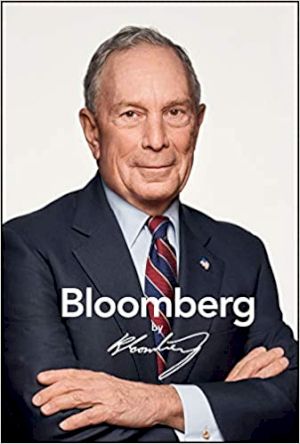24 April 2020
Bloomberg by Bloomberg
Michael R Bloomberg
2019, John Wiley, 256 pages,
ISBN 9781119554264
Reviewer: Ian Harwood

Michael Bloomberg stepped squarely into the public eye late last year when he launched his short-lived and ultimately unsuccessful bid to gain the Democratic Party candidacy ahead of the upcoming November 2020 US presidential election.
Prior to that he had become well-known internationally as a highly successful ( Republican) Mayor of New York City having won three successive four-year terms in that high-profile office, the first of which began in the immediate wake of the 9/11 terrorist attacks.
A distinctive aspect of both these forays into politics was the amount of his own money he spent on his campaigning – exceptional amounts even by the extra-ordinarily high-spending standards of the world’s most prosperous economy. But then this this money came out of the fortune of a man estimated by Forbes magazine to be among America’s richest who is also, it should be said, a philanthropist on an impressively generous scale.
This book – an autobiography – has as its key underlying theme how Michael Bloomberg made his fortune. This he did, first, by working assiduously as a Wall Street stockbroker and being “exited” with a pay-off of $10 million and, subsequently, by establishing the eponymous Bloomberg Corporation. The latter – which has long been a proverbial Titan in the massively important world-wide business of the creation and transmission of economic and financial data and news –remains a private company in which the founder retains an overwhelming majority stake.
There is much talk nowadays of “digital disruption”, with many start-up companies endeavouring to achieve ascendancy in their chosen “target” sphere via this route. Bloomberg, though, provides a path-breaking example of the implementation of this process from the early 1980s onwards when propitious economic circumstances and deregulation unleashed the financial industry’s creative juices and the process of “financial globalisation” began to take off in a steep and uninterrupted climb.
Having cut his teeth at Salomon Brothers pulling together internal financial information in inventive and unprecedented fashion, Bloomberg subsequently perceived the opportunity to create an exceptional product –the Bloomberg Terminal which packaged a wealth of financial data in accessible and easily manipulable form –to the fast-burgeoning financial industry in general. He subsequently followed this with the creation of a world-wide economic and financial news service.
In so doing he went head-to-head with incumbents, notably Dow Jones and Reuters, and ultimately prevailed to stand as the global financial markets’ primary “real-time” information source. Indeed, a Bloomberg subscription has been the sine qua non of professional participation in financial markets for a very considerable time.
To all those who ply their trade in financial markets – and those in finance ministries and central banks who need to keep an eye on how financial markets are behaving – Bloomberg’s telling how his opportunity-seeking and energetically pro-active company blazed its innovative way to ascendancy is a story well worth reading.
Anybody hoping for Bloomberg’s reflections of the fast-changing global economic and financial environment his company has navigated for almost forty years, however, is going to be disappointed. Indeed, any reference to what might be described as “defining events” is limited to the fall of the Berlin Wall and the end of the Cold War. This apart, observations on what was happening in the wider world are entirely absent.
But this, clearly, was never part of Michael Bloomberg’s purpose in writing this book. Rather his intent is to explain why his company has been so successful in seizing opportunities offered by a fast-changing environment and much advice is offered on this score. Overall, though, he attributes his success to three basic factors: unstinting hard work; the skill to work with others and “plain old-fashioned luck”.
